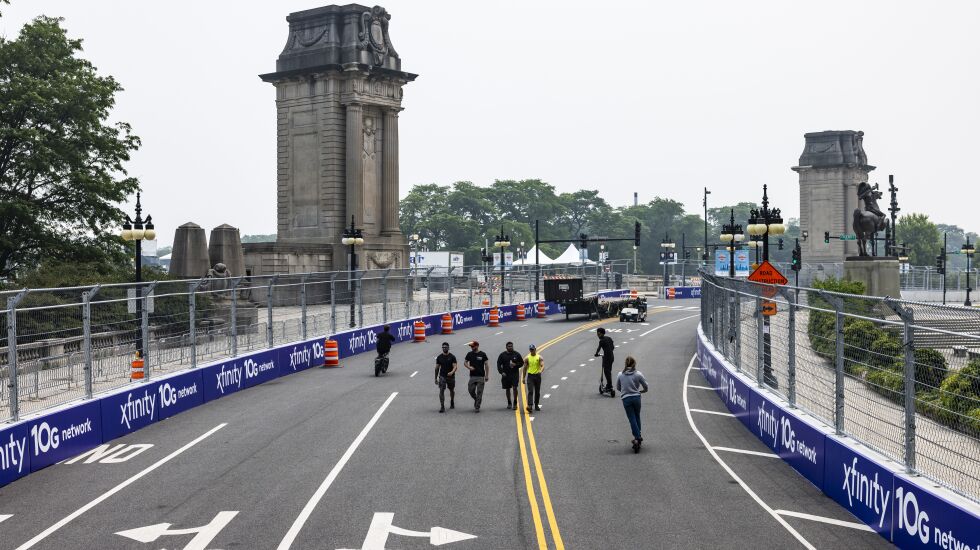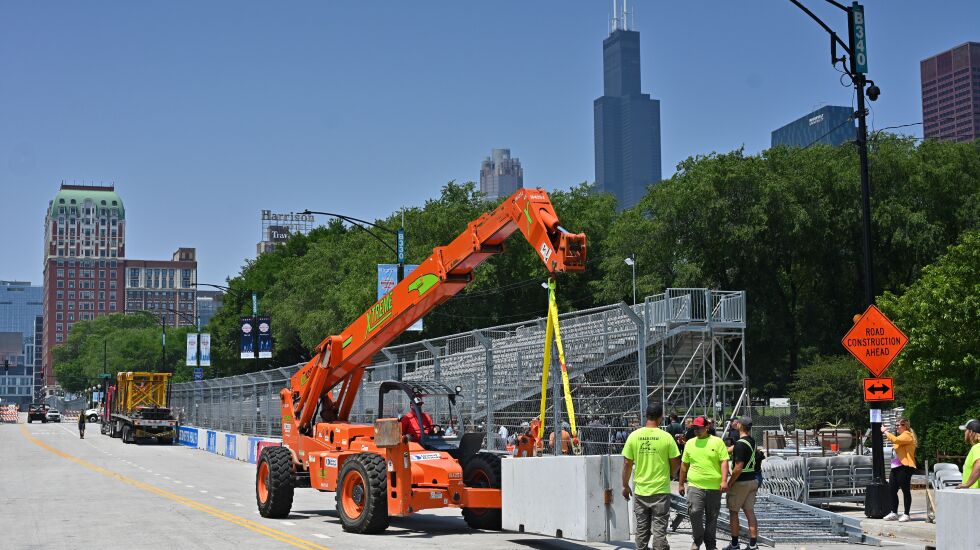
Flatbed trucks have been carrying thousands of concrete barrier walls along Interstate 94 over the last two weeks for NASCAR’s Chicago Street Race.
Loaded with four barriers each, the trucks have made more than 500 trips from a concrete factory in south suburban Lynwood, where 2,200 sections were built for this weekend’s races.
“If you happen to be driving up I-94, you probably have seen a lot of these on the road,” said Dan Pedowitz, director of customer solutions at Worldwide Express, a Dallas-based logistics company that’s been moving the barriers.
The barrier walls, weighing 9,500 pounds each, are designed to keep spectators safe from crashes at the 2.2-mile course looping around DuSable Lake Shore Drive and Michigan Avenue.
NASCAR officials say the design of the barriers is the gold standard of street racing.

The barriers are approved by the Federation Internationale de l’Automobile, or FIA —the governing body for motorsport, said Jeremy Casperson, NASCAR’s director of civil engineering.
The barriers are used widely at other events like Formula One and IndyCar.
“They’ve been tested, and we’re very confident they’ll do their job,” Casperson said during a tour of the track in mid-June.
Each concrete barrier is 4 feet high and topped by an 8-foot fence designed to catch debris from crashes. Those fences are owned by NASCAR and were shipped from Nashville, Pedowitz said.
The barriers play an important part in protecting spectators from crashes, which happen an estimated 220 times a year in NASCAR — about six per race.
The fences and walls are bound together by steel cables. The system allows the barriers to move slightly upon impact to absorb a crash, NASCAR says.

The barriers are different from the ones used in typical NASCAR oval races. Those barriers, known as SAFER barriers, use foam to cushion impacts on the steel wall. They were used in NASCAR’s other nontraditional race at the Los Angeles Memorial Coliseum in February.
The fully concrete barriers for the Chicago Street Race were built for NASCAR this year in Lynwood, about 30 miles south of downtown, at Avan Precast Concrete, Pedowitz said.
Flatbed trucks have been delivering them to a staging area near McCormick Place since mid-June, Pedowitz said.
From the staging area, trucks have been dropping them off at the track. The last barriers will be placed Friday after DuSable Lake Shore Drive is closed for the race.
After the race, the barriers will be moved to an empty yard in the South Loop, Pedowitz said.

NASCAR plans to re-use the barriers for the next two years of scheduled street races in Chicago, Pedowitz said.
For added protection against crashes, packs of tires are placed at the course’s 12 turns, where the risk of crashes occurring is higher.
Around 9,000 tires were bound into packs about eight tires high for this race, Pedowitz said. The tires were made by Goodyear to be used as crash barriers, he said.
About 20 truckloads of tires were sent from Lawton, Oklahoma, to Chicago Speedway in Joliet, Pedowitz said. They were assembled into packs there, then loaded on flatbed trailers and brought to Chicago.
NASCAR designed the street course while considering a mandatory 15-foot buffer between the barrier walls and spectator seating.
On Balbo Drive, the barriers were placed several feet from the curb to allow the grandstands to be placed near the edge of the sidewalk, NASCAR said.
“When you look at the course and the location of those barriers, a lot of it plays into where those seating areas are,” NASCAR Chicago Street Course President Julie Giese said at a walk-through of the course with reporters this month.
“So it really is a bit of a jigsaw puzzle, honestly, as we were starting to put those things together,” she said.

Editor’s note: Worldwide Express is based in Dallas. An earlier version of this article contained incorrect information.







